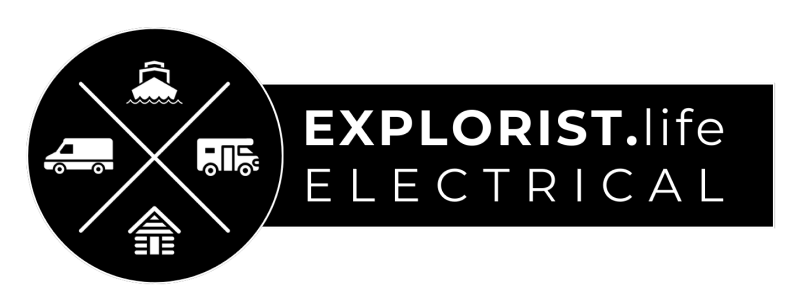
Today, we are going to cover the important considerations for choosing between a 12-volt, 24-volt, or 48-volt battery system. This lesson is part of the Battery Basics Playlist from the EXPLORIST.life Mobile, Marine, and Off-Grid Electrical Academy.

12V, 24V, and 48V System Considerations – VIDEO

Understanding Battery System

Voltages
When we talk about system voltage, we’re referring to the voltage of the entire battery bank—not just individual batteries. For example, a single 12-volt battery is a 12-volt system. But you could also build a 48-volt battery bank using four 12-volt batteries wired in series.
So when we say 12V, 24V, or 48V systems, we’re talking about the overall operating voltage of the full bank.
Starting Point: Inverter Size

The first thing to consider when choosing a system voltage is the size of your inverter, or your overall inverting needs.

- A 3,000-watt inverter at 12V will pull about 250 amps at full load.
- A 5,000-watt inverter at 12V will pull over 400 amps—an impractical amount of current.
- Trying to run 10,000 watts at 12V would mean over 800 amps, which isn’t realistic or safe.
This is why larger inverter capacities generally require higher system voltages. For example:
Wire Size and Amperage Considerations

Wire size is another important factor. For example:
- A 3,000-watt 12V inverter requires 4/0 wire, which is common and practical.
- A 5,000-watt 12V inverter requires two sets of 4/0 wire for both positive and negative runs—expensive and unwieldy.
- At 24V or 48V, the amperage is reduced, allowing for smaller and more manageable wire sizes, such as 1/0 for larger systems.
Equipment Availability

System voltage decisions are also influenced by what parts are available. For instance:
- Victron offers 12V and 24V DC-to-DC chargers, but not 48V options.
- For 48V systems, alternatives like the Sterling DC-to-DC charger are available.
So, if brand matching or integration with Victron components is a priority, that can sway your choice.
Solar Input Capacity

The amount of solar you plan to install also plays a big role:
- A 12V system can handle about 1,450 watts of solar on a single 100-amp charge controller.
- A 24V system can handle up to 2,900 watts on one controller.
- A 48V system can handle up to 5,800 watts with a single controller.
More solar is possible on lower voltages, but it requires multiple controllers, adding cost and complexity.
Application Scenarios

- Mobile Applications (Vans, RVs, Boats):
Depending on your inverter size and shore power input (30A vs 50A), you may be limited to certain system voltages. For many mobile applications, 12V and 24V systems are common, but 48V is preferred for higher power needs. - Off-Grid Homes and Cabins:
For stationary systems, 48V is almost always recommended. It integrates easily with residential breaker panels, reduces wire size requirements, and avoids the limitations of alternator-based charging found in mobile setups.
Key Takeaways
- Smaller systems (up to ~3,000 watts) can often stay at 12V, but wiring and amperage quickly become limiting factors.
- Medium systems (~5,000 watts) are best at 24V or 48V.
- Large systems (10,000+ watts or off-grid homes) should almost always be 48V.
- Consider not just your power needs, but also wire size, part availability, solar input, and application type when deciding.
Closing Thoughts
This has been a detailed lesson on 12V, 24V, and 48V system considerations. These recommendations are based on our experience designing and supporting over 30,000 electrical system installations through EXPLORIST.life.
If you need help selecting or designing a system, support is available at shop.explorist.life/support.

